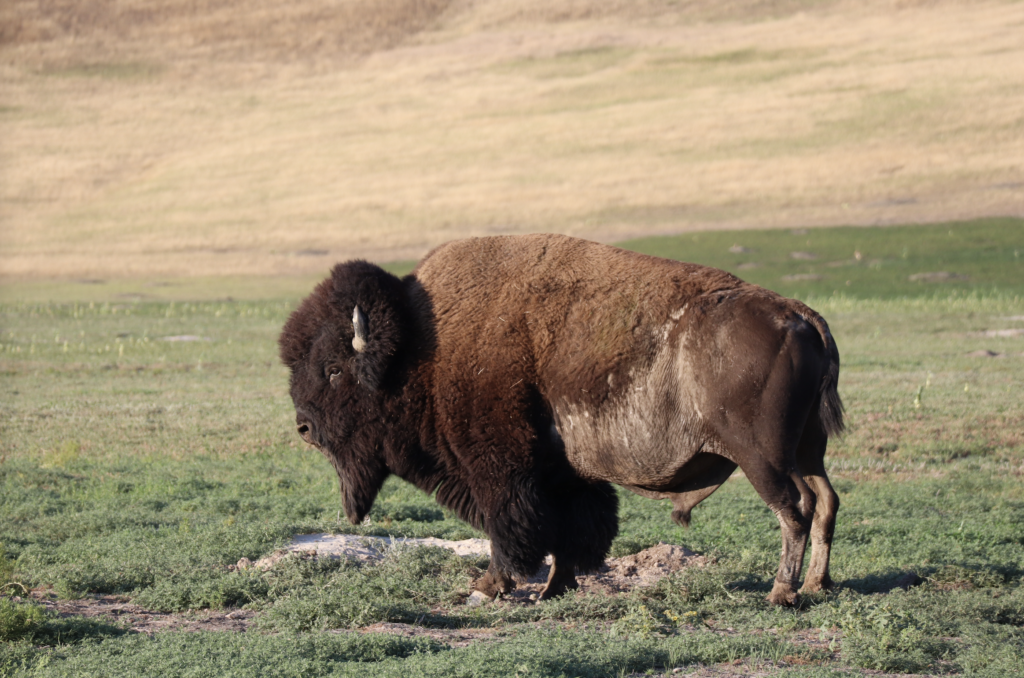There’s a bull bison rolling on the ground. Hooves point skyward as the bull’s body moves—rocking, kicking, sliding on a carefully chosen patch of earth. Dust hangs in the hot summer air. Other bison look on at the commotion, then return to grazing. A calf imitates the bull, playfully rolling under mom’s legs. What are these bison doing?
This is a classic summer scene where bison roam. Peculiar, dirt seeking behavior like this is called wallowing. Wallowing brings a variety of benefits to bison. The movement jostles off insects, the dirt coating provides protection from the sun, and the wallow they create becomes a social gathering place (Olson, 2022).
The bull bison gets up and wanders off. A yearling bull takes his place, and he is joined by another. Every new bison that uses the wallow deepens the depression and widens the circle. They’ll share this wallow until they migrate for fresh grass. The grass in this pasture will grow back, and the bison chips left by the herd will feed the soil and disappear. In a few months, most traces of this herd will be indiscernible on the landscape. But the bison wallow remains a prominent feature for years or even decades. The oldest depressions are referred to by researchers as “relict wallows” (Nickell, 2018).

What seems like an unremarkable patch of earth—the wallow—plays an important role in prairie ecosystems. Wallowing creates a disturbance in the landscape, and that disturbance provides an opportunity for the web of life to work its magic. The collective weight of dozens of bison compacts the soil under a wallow. Water drains much more slowly from these places compared to the surrounding prairie. When the rains come, a wallow transforms into a temporary pool. These pools are oases in the arid expanse of the Great Plains. Insects thrive in and around the shallow water. Amphibians eat those insects and grow into frogs. Swift foxes, coyotes and eagles eat the frogs. This circle continues, a legacy of the long-gone bison herd (Gerlanc, 2004).
The Great Plains were covered with wallows when there were millions of bison on the landscape. But with the bison gone, the wallows disappeared too. The depressions were filled in or smoothed over by plows. Cattle couldn’t replace bison– they don’t wallow.
Bison herds have great power and impact on grasslands. Researchers call them “ecosystem engineers”, species capable of altering landscapes promoting resiliency, abundance, and biodiversity (Nickell, 2018). Wallowing is one of the many ways bison support the other beings around them. Returning bison bring life with them for the frogs, insects, and people alike.
Works Cited
OLSON, W. (2022). ECOLOGICAL BUFFALO: On the Trail of a Keystone Species. University of REGINA PRESS.
Nickell, Z., Varriano, S., Plemmons, E., & Moran, M. D. (2018). Ecosystem engineering by bison (Bison bison) wallowing increases arthropod community heterogeneity in space and time. Ecosphere, 9(9), e02436.
Gerlanc, N. M. (2004). Bison wallows: community assembly and population dynamics in isolated ephemeral aquatic habitats of the tallgrass prairie. Kansas State University.

Ross Martin, Western Resource Fellow | Ross is a Masters of Environmental Management candidate at the Yale School of the Environment. His focus is on wildlife coexistence, ecosystem connectivity, environmental sociology, and the repopulation of bison in North America. Prior to graduate school, he worked in public policy, decarbonization campaigns, grassroots activism, and the conservation of wildlife in the Greater Yellowstone Ecosystem. As a Western Resource Fellow, Ross will work with Tanka Fund, a South Dakota nonprofit returning bison to native lands, lives and economies in the American West. See what Ross has been up to. | Blog
